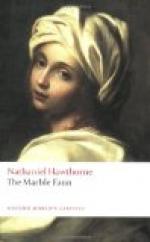But lovers, and Kenyon knew it well, project so lifelike a copy of their mistresses out of their own imaginations, that it can pull at the heartstrings almost as perceptibly as the genuine original. No airy intimations are to be trusted; no evidences of responsive affection less positive than whispered and broken words, or tender pressures of the hand, allowed and half returned; or glances, that distil many passionate avowals into one gleam of richly colored light. Even these should be weighed rigorously, at the instant; for, in another instant, the imagination seizes on them as its property, and stamps them with its own arbitrary value. But Hilda’s maidenly reserve had given her lover no such tokens, to be interpreted either by his hopes or fears.
“Yonder, over mountain and valley, lies Rome,” said the sculptor; “shall you return thither in the autumn?”
“Never! I hate Rome,” answered Donatello; “and have good cause.”
“And yet it was a pleasant winter that we spent there,” observed Kenyon, “and with pleasant friends about us. You would meet them again there—all of them.”
“All?” asked Donatello.
“All, to the best of my belief,” said the sculptor: “but you need not go to Rome to seek them. If there were one of those friends whose lifetime was twisted with your own, I am enough of a fatalist to feel assured that you will meet that one again, wander whither you may. Neither can we escape the companions whom Providence assigns for us, by climbing an old tower like this.”
“Yet the stairs are steep and dark,” rejoined the Count; “none but yourself would seek me here, or find me, if they sought.”
As Donatello did not take advantage of this opening which his friend had kindly afforded him to pour out his hidden troubles, the latter again threw aside the subject, and returned to the enjoyment of the scene before him. The thunder-storm, which he had beheld striding across the valley, had passed to the left of Monte Beni, and was continuing its march towards the hills that formed the boundary on the eastward. Above the whole valley, indeed, the sky was heavy with tumbling vapors, interspersed with which were tracts of blue, vividly brightened by the sun; but, in the east, where the tempest was yet trailing its ragged skirts, lay a dusky region of cloud and sullen mist, in which some of the hills appeared of a dark purple hue. Others became so indistinct, that the spectator could not tell rocky height from impalpable cloud. Far into this misty cloud region, however,—within the domain of chaos, as it were,—hilltops were seen brightening in the sunshine; they looked like fragments of the world, broken adrift and based on nothingness, or like portions of a sphere destined to exist, but not yet finally compacted.
The sculptor, habitually drawing many of the images and illustrations of his thoughts from the plastic art, fancied that the scene represented the process of the Creator, when he held the new, imperfect earth in his hand, and modelled it.




